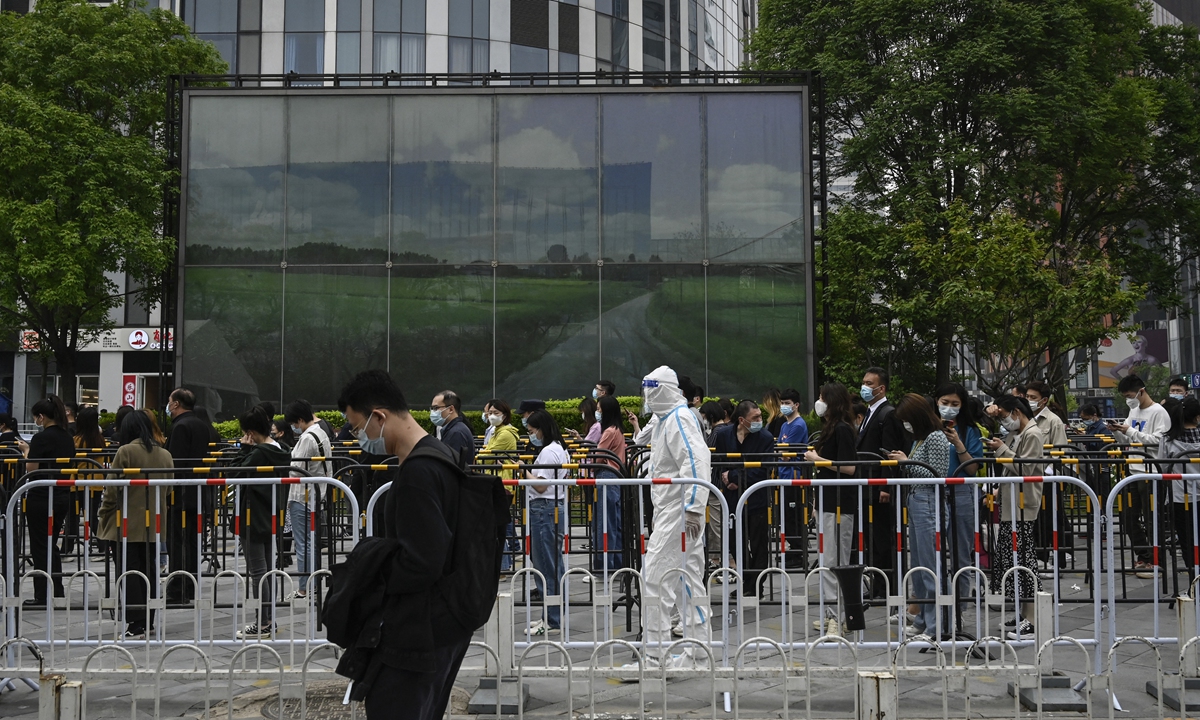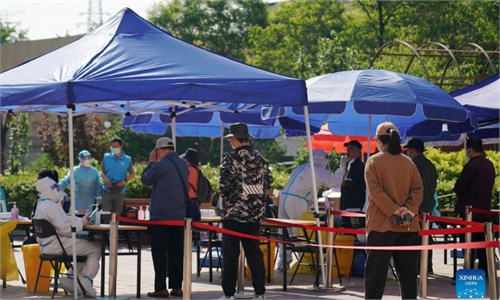Beijing still in 'tug of war' against Omicron
Infections in communities cleared for 1st time after 8 rounds of screening

People wait in line to be tested for COVID-19 at a swab collection site in Beijing on April 25, 2022. Photo: AFP
Over the past weekend, Beijing reported a total of 137 domestically transmitted COVID-19 infections. Yet, a piece of great news is being highlighted by experts amid the virus-hit capital's weeks-long tug-of-war against Omicron - on Sunday, the city saw no new infections at the community level for the first time after eight rounds of mass nucleic acid screening.
But the Beijing municipal government still reminded the public that the number of infections per day is still high and there is a risk of sporadic cases circulating in communities. "At present, the prevention and control of the epidemic in Beijing is at a critical moment, which requires effort," Beijing municipal government spokesman Xu Hejian said at a press briefing on Sunday.
Chaoyang district, which has reported the most cases, also upgraded the level of prevention and control measures in the region on Sunday, including increased testing frequency for people living with those who are quarantined at home. The government also called on residents in the district to stay put as much as possible.
Since April 25, Beijing has held eight rounds of region-wide mass nucleic acid tests. Although Beijing has been implementing timely risk controls for the infected population and close contacts, infections at the community level emerging daily have been reported, and were considered by experts to be a hindrance to Beijing's rapid quelling of the outbreak.
On Sunday, Beijing reported zero cases at the community level for the first time in the past two weeks.
"It is a very good sign that there are no new confirmed cases in the community screening outside the control area," a Chinese CDC expert told the Global Times on condition of anonymity on Sunday. "It means that the epidemic prevention situation in the city is getting better and the spread of the epidemic will be gradually controlled."
But the expert noted that it cannot conclude that the risk of virus transmission at the community level has been completely blocked.
"If this clearance is sustained in the coming days, it indicates that Beijing has reached a relatively good balance between epidemic prevention and control, residents' livelihoods, and economic and social development at this time," the expert said.
From April 22 until 3 pm on Sunday, Beijing reported a total of 727 infections in the current round of the outbreak, including 299 cases in Chaoyang district and 195 in Fangshan district. However, no districts, including those two that have reported hundreds of infections, have implemented widespread lockdowns. This is expected to be an example for future epidemic prevention efforts in other Chinese cities, observers noted.
Convenient and high-frequency nucleic acid testing is the key to containing the latest outbreak, noted the anonymous CDC expert. "As the outbreak is caused by the Omicron variant, patients don't generally show serious symptoms. It is difficult to detect infections without large-scale nucleic acid testing."
Currently, no COVID-19 infections have been found in Beijing through participating in nucleic acid testing, officials said at Sunday's briefing.
Of the 727 infected people reported in Beijing in the current outbreak, only one of them developed serious symptoms - a 79-year-old who was not fully vaccinated. Of those infected, 686 had been vaccinated, with 588 completing two or three doses of the COVID-19 vaccine.
Beijing has seen few serious cases or deaths in the current round of the outbreak, most notably because the scope of infection is very limited and high-risk groups have not been infected, experts noted.
"Of the infected people in Beijing in total, the proportion and number of elderly people is very low. But if there are hundreds of thousands of people infected, then the risk for the elderly is high," the expert from the CDC said, stressing the importance of completing vaccinations, especially for the elderly, children and people with chronic diseases.
Health experts also refuted suggestions that China's epidemic control measures are inadequate against Omicron or are too costly to the economy and people's livelihoods.
Beijing is now adopting an active response strategy to the virus, with about a dozen cases being reported each day. For the Omicron outbreak, that number is quite small, Wang Guangfa, a Beijing-based respiratory specialist, told the Global Times.
"Without such a strategy, the number of new cases could run up to thousands or tens of thousands. The number of infections in vulnerable populations would increase dramatically," he said. "This is unacceptable to the general public in China."
Wang also pointed out that the calculation of costs and benefits in epidemic prevention cannot be based only on a short-term slide in production.
Considering the medical resources, the loss of lives, and the social burden caused by a serious outbreak, China's choice to aggressively control the outbreak at an early stage can significantly reduce its impact on society and people's livelihoods in the long run, he said.



